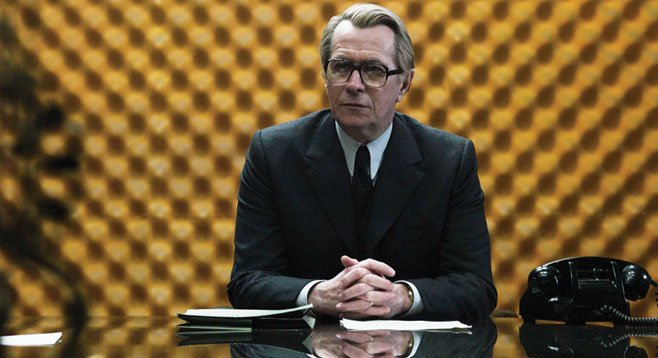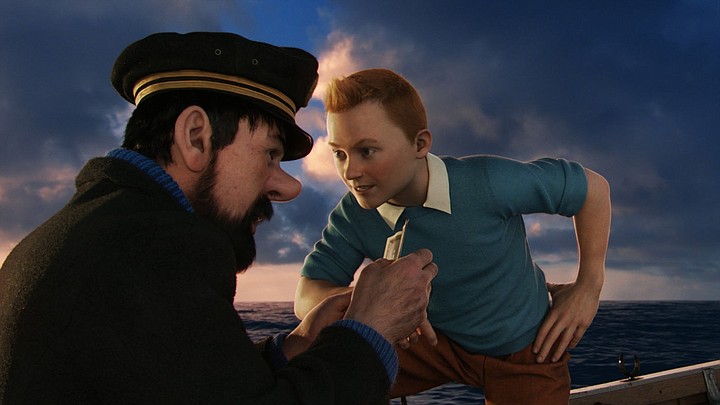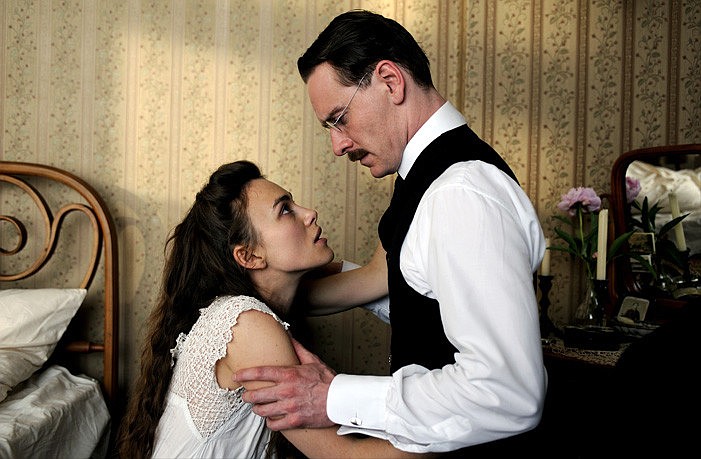 Facebook
Facebook
 X
X
 Instagram
Instagram
 TikTok
TikTok
 Youtube
Youtube

An intricate condensation of John le Carré’s novel, previously a BBC sprawler starring Alec Guinness. As the very dry, very British spy master Smiley, Gary Oldman is nearly at Sir Alec’s level. Tomas Alfredson’s film is all micro-plot observation, with expert details that link, fester, and spin webs. Sad, brainy, desperate lives carry on as if the games really matter, and there is wit in the folly. Impeccably used are Tom Hardy, John Hurt, Benedict Cumberbatch, Colin Firth, Ciarán Hinds, Toby Jones and, well, everyone. Not a movie for lazy viewing.
Playing George Smiley in the new film of John le Carré’s most famous book, Gary Oldman is a long, gentlemanly way from his punky Sid Vicious in 1986’s Sid and Nancy. At times he is as dry, withered, and recessive as a papier-mâché corpse, ready to blow away in a chill London breeze. But Smiley, who rarely smiles, is always thinking, always watching, and on his sagging shoulders rides the future of “the Circus” (le Carré lingo for the British secret service).
It is doubtful that fans of Oldman’s Vicious or his Sirius Black in the Harry Potter saga will rush to his new triumph. Nor will many under 50 realize that Oldman walks so bravely in the shadow of Sir Alec Guinness. It was Guinness, pale and puffy, who carried the glum cerebral weight of spymaster Smiley in the BBC Tinker Tailor Soldier Spy, 315 British TV minutes in 1979.
Sir Alec gave the devious games a faintly cherubic twinkle, but his chill stare and exquisitely measured sentences, which so often seemed to be words hiding thoughts, were like gossamer webs of danger. Oldman, for all of his mandarin poise, good diction, and refined pinches of pain, cannot equal Guinness, who had the greatest English acting career on film (after the era of Chaplin, Grant, and Laughton). Some believe that Oldman is imitating Guinness. I would say that he is doing a very similar kind of Englishman.
The TV epic was a dark maze through which I stumbled with an inadequate flashlight (pardon me, “torch”). I never grasped it all, not even as Guinness delineated the plot moves with chess-master calm. But, oh, the acting, the atmospherics, the Britannic majesty of condescension! It was the x-ray of a great empire in final retreat (once more, American “allies” are minor players; the Soviets pull most of the strings that bedevil the Circus). Tomas Alfredson’s engrossing film, adapted by Peter Straughan and the late Bridget O’Connor, spends 127 minutes pinballing from London to Budapest to Paris to Istanbul to Moscow, then back to London.
Again, it’s the Cold War of the 1970s. The Beatles fuzz has flaked away, computers are not yet in charge, and Smiley suspects that there is a Soviet mole high up on the Circus wires. The notion was first broached to him by aging Control (John Hurt, yet not enough Hurt — when is there ever enough Hurt?). After both are shunted aside by more sinister players, Smiley leads a secret team (a key member is Benedict Cumberbatch, British TV’s recent Sherlock Holmes) to ferret through the subtle, covert clues. Those must lead to one or more of the four men who are so smugly rising at London HQ: Percy (Toby Jones), Bill (Colin Firth, not stuttering), Roy (Ciarán Hinds), and Toby (David Dencik).
The British do group acting the best. This is a master class, its lessons set in the aspic of sardonic wit. In the infallible cast Christian McKay (of Me and Orson Welles) is sadly wasted, but Tom Hardy is remarkable as a sexy, squirming agent, the one who most needs to come in from the cold. As truths spill and merge in murk, the infidelity of Smiley’s wife is only a passing stain.
Alfredson and cinematographer Hoyte Van Hoytema make much, without fuss, of even tiny scenes. Details grip our interest: teeth dryly crunching toast, a buzzing bee in a car, the urgency of a bike’s bell, the sign “Remember: Telephone Service Is Not Secure” deep in the entrails of the Circus, a nursing mother in dire peril, the sound of Julio Iglesias singing “La Mer,” the subversive humor of the boozed Circus staff capping their Christmas party with the Soviet anthem. “Nothing’s genuine anymore,” laments Control, but Tinker, crawling across its tense, clinging web of shame and betrayal, feels absolutely genuine.

I first heard about the Franco-Belgian comic-book detective Tintin from schoolboys in Louis Malle’s great Murmur of the Heart:
Laurent: “You got the latest Tintin?”
Friend: “The one before was funnier.”
Now Steven Spielberg has directed The Adventures of Tintin. The French word that applies is pastiche. Compiled from three comic books of the famed Hergé (born Georges Rémi), it didn’t make me want to see the sequel clearly indicated at the end, and I didn’t find it funny. It is like a string of Hardy Boys stories given a glazing of style. We can glaze over in response. Motion-capture techniques mimic the clear-cut look of Hergé’s comics, but it feels like bloodless animation (that is, no cartooning) and never captured credible emotion.
Hergé said, “I consider my stories as movies.” Fine, but the movieness is now mostly effects and voices (Jamie Bell as Tintin, also Daniel Craig, Andy Serkis, Cary Elwes). Spielberg and his lavish team mold the clay of cliché: obsessive momentum, facile clues, glittering objects (some beautiful ship models are sadly wrecked), bloodless violence, even an odd little bestiality gag. Boy-hero Tintin, who seems 15 going on 40, fights off men twice his size while sleuthing elaborate mysteries with his dog Snowy. The time is the 1930s, but no one frets about Hitler and Mussolini. For a sanitizing reason: Hergé’s early work was lightly salted with racism and anti-Semitism, and he snuggled up to Hitler’s “New Order” in Belgium (later apologizing as if to say, “Oh, you know, us artists...”).
Boys aged 7 to 12 may enjoy the action. Anyone much older will drop into a funk. The movie is a crank up that just keeps cranking. How odd it is, that two top American directors currently celebrate old French-culture icons. But with his salute to Georges Méliès in Hugo, Martin Scorsese shows serious imagination. For Hergé, Spielberg only spins the expensive wheels of his status while his talent leaks away.
Freud may be out of fashion, but he shouldn’t be boring. Freud (Viggo Mortensen) and Jung (Michael Fassbender) and their patient who became a brainy disciple and colleague, Sabina Spielrein (Keira Knightley), trade analytic ideas and furtive, sado-masochistic feelings. Knightley bravely uses her beauty, even jutting out her jaw a few times like Billy Bob Thornton in <em>Sling Blade. </em>But she never finds leverage, and the film seems more like a footnoted thesis than a triangle of destiny. John Huston made the once-bold therapies more risky and challenging in Freud, partly by tormenting Montgomery Clift.

Because Keira Knightley is so beautiful, many fans want her to appear beautifully. She puts that beauty at risk in her performance as Sabina Spielrein in A Dangerous Method. Tense as a trap, she contorts her body, even juts her lower jaw somewhat like Billy Bob Thornton in Sling Blade. The English actress uses a rather American accent, though Sabina was a Russian Jew fluent in German. Virginal, love-hate fears about her cruel, domineering father caused hysteria, and then she met Dr. Carl Jung (Michael Fassbender), a rising disciple of Dr. Sigmund Freud (Viggo Mortensen).
This makes the prim, Swiss, married Jung a little nuts. Soon he and Sabina are violating the stern protocols of classical psychoanalysis by having an affair that features sado-masochism. Freud, acted like a Jewish pope by Mortensen (with, yep, a phallic cigar), is more distantly entangled. He nudges along Sabina’s therapy while enjoying the gossip. In a fine tangle of irony, Jung’s sweet wife (Sarah Gadon) will eventually ask the improved, now deeply Freudian Sabina to analyze her guilty husband. Occurring from 1904 to 1913, the story seems timid, as if scared of an obscure scandal now a century old.
The old truisms apply: Freud as the magisterial father figure and stern rationalist, with Jung as the rebel son, not Jewish but instinctively mystical. We also get a sense that Spielrein generated important ideas (she was later, in the wartime Soviet Union, a victim of Hitler). Though handsomely made, this is David Cronenberg’s most sedate, passive movie. While not supine on a couch, it is often listless. John Huston churned up more panic and drama with Freud (1962), in part because star Montgomery Clift felt cornered by Huston’s scorn for Clift’s “weakness” (homosexuality). Though Freud is out of fashion now, he shouldn’t be boring.
Reviewed in the movie capsules: Alvin & the Chipmunks: Chipwrecked, The Girl with the Dragon Tattoo, Mission: Impossible — Ghost Protocol.


An intricate condensation of John le Carré’s novel, previously a BBC sprawler starring Alec Guinness. As the very dry, very British spy master Smiley, Gary Oldman is nearly at Sir Alec’s level. Tomas Alfredson’s film is all micro-plot observation, with expert details that link, fester, and spin webs. Sad, brainy, desperate lives carry on as if the games really matter, and there is wit in the folly. Impeccably used are Tom Hardy, John Hurt, Benedict Cumberbatch, Colin Firth, Ciarán Hinds, Toby Jones and, well, everyone. Not a movie for lazy viewing.
Playing George Smiley in the new film of John le Carré’s most famous book, Gary Oldman is a long, gentlemanly way from his punky Sid Vicious in 1986’s Sid and Nancy. At times he is as dry, withered, and recessive as a papier-mâché corpse, ready to blow away in a chill London breeze. But Smiley, who rarely smiles, is always thinking, always watching, and on his sagging shoulders rides the future of “the Circus” (le Carré lingo for the British secret service).
It is doubtful that fans of Oldman’s Vicious or his Sirius Black in the Harry Potter saga will rush to his new triumph. Nor will many under 50 realize that Oldman walks so bravely in the shadow of Sir Alec Guinness. It was Guinness, pale and puffy, who carried the glum cerebral weight of spymaster Smiley in the BBC Tinker Tailor Soldier Spy, 315 British TV minutes in 1979.
Sir Alec gave the devious games a faintly cherubic twinkle, but his chill stare and exquisitely measured sentences, which so often seemed to be words hiding thoughts, were like gossamer webs of danger. Oldman, for all of his mandarin poise, good diction, and refined pinches of pain, cannot equal Guinness, who had the greatest English acting career on film (after the era of Chaplin, Grant, and Laughton). Some believe that Oldman is imitating Guinness. I would say that he is doing a very similar kind of Englishman.
The TV epic was a dark maze through which I stumbled with an inadequate flashlight (pardon me, “torch”). I never grasped it all, not even as Guinness delineated the plot moves with chess-master calm. But, oh, the acting, the atmospherics, the Britannic majesty of condescension! It was the x-ray of a great empire in final retreat (once more, American “allies” are minor players; the Soviets pull most of the strings that bedevil the Circus). Tomas Alfredson’s engrossing film, adapted by Peter Straughan and the late Bridget O’Connor, spends 127 minutes pinballing from London to Budapest to Paris to Istanbul to Moscow, then back to London.
Again, it’s the Cold War of the 1970s. The Beatles fuzz has flaked away, computers are not yet in charge, and Smiley suspects that there is a Soviet mole high up on the Circus wires. The notion was first broached to him by aging Control (John Hurt, yet not enough Hurt — when is there ever enough Hurt?). After both are shunted aside by more sinister players, Smiley leads a secret team (a key member is Benedict Cumberbatch, British TV’s recent Sherlock Holmes) to ferret through the subtle, covert clues. Those must lead to one or more of the four men who are so smugly rising at London HQ: Percy (Toby Jones), Bill (Colin Firth, not stuttering), Roy (Ciarán Hinds), and Toby (David Dencik).
The British do group acting the best. This is a master class, its lessons set in the aspic of sardonic wit. In the infallible cast Christian McKay (of Me and Orson Welles) is sadly wasted, but Tom Hardy is remarkable as a sexy, squirming agent, the one who most needs to come in from the cold. As truths spill and merge in murk, the infidelity of Smiley’s wife is only a passing stain.
Alfredson and cinematographer Hoyte Van Hoytema make much, without fuss, of even tiny scenes. Details grip our interest: teeth dryly crunching toast, a buzzing bee in a car, the urgency of a bike’s bell, the sign “Remember: Telephone Service Is Not Secure” deep in the entrails of the Circus, a nursing mother in dire peril, the sound of Julio Iglesias singing “La Mer,” the subversive humor of the boozed Circus staff capping their Christmas party with the Soviet anthem. “Nothing’s genuine anymore,” laments Control, but Tinker, crawling across its tense, clinging web of shame and betrayal, feels absolutely genuine.

I first heard about the Franco-Belgian comic-book detective Tintin from schoolboys in Louis Malle’s great Murmur of the Heart:
Laurent: “You got the latest Tintin?”
Friend: “The one before was funnier.”
Now Steven Spielberg has directed The Adventures of Tintin. The French word that applies is pastiche. Compiled from three comic books of the famed Hergé (born Georges Rémi), it didn’t make me want to see the sequel clearly indicated at the end, and I didn’t find it funny. It is like a string of Hardy Boys stories given a glazing of style. We can glaze over in response. Motion-capture techniques mimic the clear-cut look of Hergé’s comics, but it feels like bloodless animation (that is, no cartooning) and never captured credible emotion.
Hergé said, “I consider my stories as movies.” Fine, but the movieness is now mostly effects and voices (Jamie Bell as Tintin, also Daniel Craig, Andy Serkis, Cary Elwes). Spielberg and his lavish team mold the clay of cliché: obsessive momentum, facile clues, glittering objects (some beautiful ship models are sadly wrecked), bloodless violence, even an odd little bestiality gag. Boy-hero Tintin, who seems 15 going on 40, fights off men twice his size while sleuthing elaborate mysteries with his dog Snowy. The time is the 1930s, but no one frets about Hitler and Mussolini. For a sanitizing reason: Hergé’s early work was lightly salted with racism and anti-Semitism, and he snuggled up to Hitler’s “New Order” in Belgium (later apologizing as if to say, “Oh, you know, us artists...”).
Boys aged 7 to 12 may enjoy the action. Anyone much older will drop into a funk. The movie is a crank up that just keeps cranking. How odd it is, that two top American directors currently celebrate old French-culture icons. But with his salute to Georges Méliès in Hugo, Martin Scorsese shows serious imagination. For Hergé, Spielberg only spins the expensive wheels of his status while his talent leaks away.
Freud may be out of fashion, but he shouldn’t be boring. Freud (Viggo Mortensen) and Jung (Michael Fassbender) and their patient who became a brainy disciple and colleague, Sabina Spielrein (Keira Knightley), trade analytic ideas and furtive, sado-masochistic feelings. Knightley bravely uses her beauty, even jutting out her jaw a few times like Billy Bob Thornton in <em>Sling Blade. </em>But she never finds leverage, and the film seems more like a footnoted thesis than a triangle of destiny. John Huston made the once-bold therapies more risky and challenging in Freud, partly by tormenting Montgomery Clift.

Because Keira Knightley is so beautiful, many fans want her to appear beautifully. She puts that beauty at risk in her performance as Sabina Spielrein in A Dangerous Method. Tense as a trap, she contorts her body, even juts her lower jaw somewhat like Billy Bob Thornton in Sling Blade. The English actress uses a rather American accent, though Sabina was a Russian Jew fluent in German. Virginal, love-hate fears about her cruel, domineering father caused hysteria, and then she met Dr. Carl Jung (Michael Fassbender), a rising disciple of Dr. Sigmund Freud (Viggo Mortensen).
This makes the prim, Swiss, married Jung a little nuts. Soon he and Sabina are violating the stern protocols of classical psychoanalysis by having an affair that features sado-masochism. Freud, acted like a Jewish pope by Mortensen (with, yep, a phallic cigar), is more distantly entangled. He nudges along Sabina’s therapy while enjoying the gossip. In a fine tangle of irony, Jung’s sweet wife (Sarah Gadon) will eventually ask the improved, now deeply Freudian Sabina to analyze her guilty husband. Occurring from 1904 to 1913, the story seems timid, as if scared of an obscure scandal now a century old.
The old truisms apply: Freud as the magisterial father figure and stern rationalist, with Jung as the rebel son, not Jewish but instinctively mystical. We also get a sense that Spielrein generated important ideas (she was later, in the wartime Soviet Union, a victim of Hitler). Though handsomely made, this is David Cronenberg’s most sedate, passive movie. While not supine on a couch, it is often listless. John Huston churned up more panic and drama with Freud (1962), in part because star Montgomery Clift felt cornered by Huston’s scorn for Clift’s “weakness” (homosexuality). Though Freud is out of fashion now, he shouldn’t be boring.
Reviewed in the movie capsules: Alvin & the Chipmunks: Chipwrecked, The Girl with the Dragon Tattoo, Mission: Impossible — Ghost Protocol.